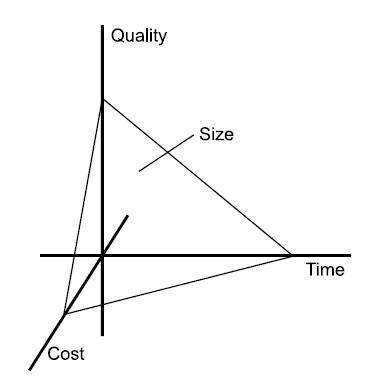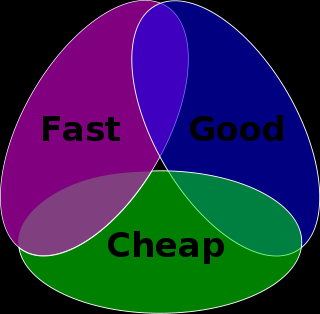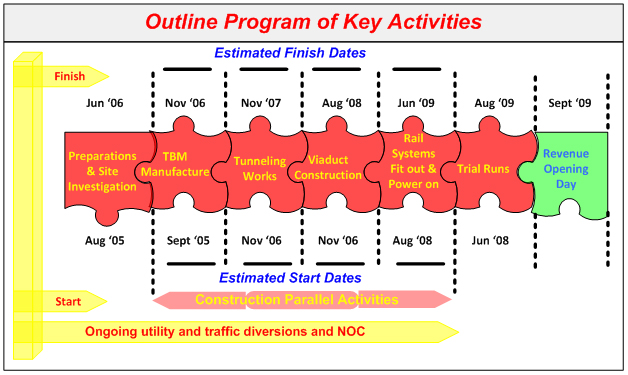Introduction
Management of projects deals with the organization of resources, time, and cost in order to achieve the desired results. A number of constraints often impact the management process associated with a given project. Dempster’s triangle has been effectively used to represent the constraints that often influence project implementation. These include project scope/quality, project schedule, and the projects’ associated costs (Kliem & Anderson, 1996: 456). These constraints are useful in the determination of whether the project is achieving its objective. It is important to acknowledge that the project deliverables are fundamentally important in establishing how successful a project is. Each individual project is compelled to take into consideration these three aspects if it is to be successfully implemented. Whether one supersedes the other in importance, remains open to discussion. As a project implementation progresses, changes and adjustments may be necessary to one of the deliverables (Gasik, 2010: 23). When such happens, it is expected that the other deliverables too would change along. For instance, an increase in cost would be expected to result in a corresponding change in quality and time (Lewis, 2005: 123). Project managers, therefore, have an obligation to maintain a balance amongst the mentioned deliverables. This paper evaluates the statement, “A project is considered to be successful if its deliverables are of agreed QUALITY, produced on TIME and to Budget (COST).” For clarity, the statement will be evaluated in the context of the Dubai metro project. Successfully evaluation requires a deeper understanding of the three deliverables aforementioned and what constitutes each.
Background information
Quality and scope are often used synonymously in project management. It provides a clear and specific statement as to the specifications agreed upon. It explicitly outlays the functions, the features, and the data as well content of the project. In general it clearly outlines the desired end outcome of the project. Costs also referred to as resources are the second component of project deliverable. Their interchangeable usage is based on the fact that resources always cost money. Whenever reference is made to project costs, it indirectly implies the resources necessary in order to facilitate its successful completion (Kliem & Anderson, 1996: 457). Such include manpower, material necessities, risk management apparatus, and any third party resources which may be required in undertaking the project. Lastly, time also referred to as schedule is of keen interest. Even the littlest of details could extremely cost project’s performance and implementation. The duration of time necessary to complete every part of the project is taken into consideration. Once the parts have been allocated time, they are further broken down into their smaller components and likewise the components allocated time. Consideration of these three key factors ensures that all the aspects which may impede implementation of given project are taken care of no matter how little they are. For instance, failure to allocate for erection of a pillar during hall construction could end up delaying the whole project, escalate the cost and eventually quality.
Perhaps a simple illustration of what a project entails would be the FIFA world cup. Often it all starts with bidding. At bidding, cost is of fundamental importance. The bidding host country must convince the selection committee that it has the ability to host the world cup in terms of resources. At this point, an assumption is often made that with adequate resources, the host country is able to overcome the challenge of time and quality. However, it never ends at that, the committee at intervals always conduct inspections to ensure that the process of preparation is on time/schedule. Schedule delays are often treated with utmost concern and the host nation is required to provide assurance that it could cover the lost time. Inspections don’t normally focus on schedule alone but also on quality of itches and other resources that would be necessary to ensure a successful tournament.
The general depiction from this simple illustration is that the project constraints are not independent from each other. Attaining desired quality must obviously cost money and time. If time is to be reduced, then the manpower has to be increased. However, it’s not always that this assumption would stand. A classical way of relating the constraints interdependence is using the constraints triangle (see diagram below) (Gasik, 2010: 24).

The general perception is that a constant sized project can have changing constraints/deliverables (Landoni & Corti, 2011: 48). However, given that the size of the triangle remains constant, altering a single constraint would definitely result into a corresponding change in the others. Every client would want a cheap, good and fast accomplished project. These are simply interpreted as time, costs and quality. The diagram below shows how these customer requirements interplay (Gasik, 2010).

The figure like the previous one displays the interrelation between the three deliverables. Basically, it shows that it is impossibility to optimize all the deliverables. Three options emerge from the triangle.
- In scenario 1, Projects implementation/design may be quick and of high quality but then its cheapness will reduce along.
- In scenario 2, project is implemented/design quickly and at reduced cost at the expense of quality.
- In scenario 3, Projects implementation/design of high quality and reduced cost but then it takes a long time to complete.
Case study: Dubai Metro Project
Dubai Metro is the first and longest fully automated rail system. The project is believed to have a risen out of necessity rather than mere development. Its major function was to serve existing areas of high travel demand including existing Old Town CBD, Sheikh Zayed Road and Dubai International Airport. Its aims included the following;
- Meet the needs of traffic demands and population increase
- Connect the main areas of Dubai and provide a fast transport service
- Reduce traffic congestion and the time of travel during rush hours
- Improve traffic safety levels
- Provide a clean environment
The above mentioned aims literally defined the deliverables of the project. On basis of the aims the project deliverables may be defined as follows:
Quality
The quality of the project defines its expected usable outcomes. To successfully offer quality, the project had to not only meet the needs of the escalating traffic demands alongside population increase but also connect the main Dubai areas. Additionally, it would facilitate improved safety levels and offer a cleaner environment. It must be mentioned that if the project failed to achieve this, then it would have failed to provide quality. The measurable quality aspects include:
- High velocity
- High reliability
- High capacity, due to short headways and large train sizes
- Fast passenger changing
- High passenger comfort
- Strong public image
The quality deliverable is defined by the following facts. The timing of the project is best illustrated by the following facts from the project. It is estimated that phase on of the project which basically consists of red and green lines will meet the needs of over 1.2 million people per day. This translates to approximately 27,000 persons in a single hour and a total passenger load of 355 million passengers annually. A total of 125 of Dubai trips will be accommodating by this phase. Other than that the project will be expected to integrate into the major operating network by RTA. The rail system will be the routes reference point. Stations for Taxi, park and ride facilities will be available in main stations to facilitate the role of the system in public transportation encouragement.
In addition, the metro will be barrier-free for the disabled. Trains are expected to come every 1.5 minutes at peak times and 3 minutes off-peak. They will be driverless which is a proven more punctual system. They will have a maximum commercial speed of 45 km/hr, although they can go up to 100 km/hr. There will be two transfer stations to allow commuters to switch between Green and Red Lines. Each of the 47 stations serving the Red and Green Lines will have pedestrian footbridge either elevated or underground so people can access the metro from both sides of the road. Also, there will be three major car parks for commuters using the Red line; one in Bur Dubai and two in Deira; which will accommodate 12,000 cars in total.
Time
Time of essence in such a project more so considering that the quality issues it is expected to address are not stagnant. If the project is then not completed within appropriate time, it would be redundant even before completion. The project’s timing is defined in phases. The Dubai Metro Project will be built in three phases with four metro lines; Red, Green, Purple & Blue with an estimated built up area of 318 kms (as demonstrated in Figure 4). RTA is currently implementing the first two lines (Red and Green) and these are scheduled to be operational in 2009. The timing is further illustrated by the figure shown below;

This will form basis for construction of an illustration Gantt chart for the project. The chart will illustrate the timing of the various phases of the project. It is important to note that as earlier mentioned, the project is divided into a number of phases. The phases are then broken down into individual components whose times are likewise scheduled.
Gantt chart

Where:
- Preparation and site investigation;
- TBM Manufacture;
- Tunneling works;
- Viaduct Construction;
- Rail system fit out and power out;
- Trial Runs and
- Revenue Opening Day
Based on the project deliverables as presented in the case of Dubai Metro project, a Gantt chart is developed as shown below. It is important that scheduling takes into consideration the resources necessary for completion of each task. If for instance a total of X dollars is needed in order to complete task 1, then such a task can only begin if the X dollars are available. At times the resources of one phase are required for the nest phase. In such an instance one task is said to depend on the other. The resources necessary for completion of the preceding task then similarly become part of the resources necessary to complete the task.
Cost
The project is generally costly and the ability of the funding body to meet its needs must be evaluated. The projects implementer must also have the resources necessary to complete the project. The costs of the project will also include the following:
- High construction costs (because of elevated tracks and tunnels)
- High infrastructure maintenance costs
- Long construction lead times (typically 5 to 7 years from concept to operation)
- Limited operational flexibility
- Negative impact on businesses adjacent to construction sites due to road and view blockages
Other than these cost constraints mentioned, the project’s budget cost estimates are summarized. The estimated costs as mentioned exclude expropriated land, major utility diversions and ground improvement. Additionally, it is clearly stated that the cash outflow depends on deliverables. The cost are defined based on the various components of the project and add up to result into the overall cost of the project. Sources of funding are identified as including metro stations sponsorship schemes, Dubai Metro’s naming rights project. These guarantee the ability of the project to meet its resource requirements. RTA raised AED 1.8 billion from its first sale of naming rights for 18 stations on the Red and Green Lines. The revenues are split between AED 886.7 million for naming rights for the stations, and AED 917 million to fund the construction of specific stations. The companies involved are mainly Dubai-based ones, including Emirates Airlines, Nakheel and Dubai Holding. Other than the already mentioned sources of finance, leasing commercial outlets at Metro stations, and rentable spaces at stations were used as sources of financing. This are expected to meet the projects financing requirements and hence resource requirements.
The costs/resource requirements for the project are as illustrated in the table below. Other than being based on project components, the table further distributes the cost as per the phases of project.
Conclusions
In conclusion, the project offers a clear depiction of project deliverables. The interplay between the deliverables to create a successful project is well elaborated and a clear understanding is developed. The project’s presentation illustrates the importance of taking into consideration all the aspects of a project prior to implementation. It generally depicts an ideal project. The quality requirements are well elaborated to include scope of the project. Likewise it illustrates the importance of cost identification and consequently the sources of funding the anticipated costs. Further, Dubai Metro project illustrates the importance of timing. Time is a project constraint which cannot be taken for granted. Each aspect of time must be included in project planning. Lack of planning could not only be costly but also compromise the overall objective of the project. For instance based on the projections of population changes in Dubai, if the project delays, then for it achieve its intended purpose, it will have to be re-drafted to accommodate the mew trends and timing. Time can therefore not be taken for granted. Lastly, Dubai Metro project offer a clear illustrations of the dependencies which exist amongst the project delivery and the effect that altering one could have on the other. As one would argue, any slight change in one deliverable must be accompanied by anticipation of change of another variable. Infrastructural development generally depicts the scenario necessary in management of an ideal project. The modern world involves complex projects which would only be successfully implemented if appropriate project management statements are adopted. It would be fallacious to attempt to run such a complex project without adequate knowledge of project management. The hitches experienced would not only impeded timely completion of the project but also facilitate escalated cost and probably eventually collapse of the project.
References
Gasik, S. (2010). A model of project knowledge management. Project Management Journal, 34(3), pp 23-24.
Kliem, R. L. & Anderson, H. B. (1996). Styles and Their Impact on Project Management Results. Project Management Journal, 27(1), pp 456-471.
Landoni, P. & Corti, B. (2011). The management of international development projects: Moving toward a standard approach or differentiation? International Journal of Project Management, 42 (2), pp 45 – 61.
Lewis, J. P. (2005). Project Planning, Scheduling & Control. New York: McGraw Hill.
